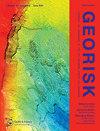Quantitatively Mapping Discolored Seawater around Submarine Volcanoes Using Satellite GCOM-C SGLI Data: A Case Study of the Krakatau Eruption in Indonesia in December 2018
IF 4.8
3区 工程技术
Q1 ENGINEERING, GEOLOGICAL
Georisk-Assessment and Management of Risk for Engineered Systems and Geohazards
Pub Date : 2023-04-03
DOI:10.3390/geohazards4020007
引用次数: 0
Abstract
The final goal of this paper is to contribute to the difficult task of understanding and forecasting submarine volcanic eruption activity by proposing a method to quantify discolored water. To achieve this purpose, we quantitatively analyzed the discolored seawater seen before and after the eruption of the marine environment around the Indonesian submarine volcano “Anak Krakatau”, which erupted at the end of December 2018, from the viewpoint of the “dominant wavelength”. The atmospherically corrected COM-C SGLI data for 17 periods from the eruption from October 2018 to March 2019 were used. As a result, the following three main items were found. First, the average ± standard deviation of the entire dominant wavelength was 497 nm ± 2 nm before the eruption and 515 nm ± 35 nm after the eruption. Second, the discolored water area around the island derived from SGLI was detected from the contour line with dominant wavelengths of 500 nm and 560 nm. Third, the size of a dominant wavelength of 500 nm or more in the discolored water areas changed in a complicated manner within the range of almost 0 to 35 km2. The area of the dominant wavelength of 500 nm or more slightly increased just before the eruption. Finally, it was proven that the “dominant wavelength” from the SGLI proposed in this paper can be a very effective tool in understanding or predicting submarine volcanic activity.利用卫星GCOM-C SGLI数据定量绘制海底火山周围变色海水:以2018年12月印度尼西亚喀拉喀托火山喷发为例
本文的最终目标是通过提出一种量化变色水的方法来帮助理解和预测海底火山喷发活动的艰巨任务。为此,我们从“主导波长”的角度,定量分析了2018年12月底爆发的印尼海底火山“喀拉喀托火山”周围海洋环境爆发前后的变色海水。使用了2018年10月至2019年3月喷发期间的17个时期的大气校正COM-C SGLI数据。结果,发现了以下三个主要项目。第一,整个优势波长的平均±标准差为喷发前497nm±2nm,喷发后515nm±35nm。其次,在优势波长为500 nm和560 nm的等高线上检测SGLI获取的岛周变色水域;在近0 ~ 35 km2范围内,变色水域500 nm及以上主导波长的大小变化较为复杂。主导波长在500纳米或以上的面积在喷发前略有增加。最后,证明了本文提出的SGLI的“主导波长”可以作为一种非常有效的工具来理解或预测海底火山活动。
本文章由计算机程序翻译,如有差异,请以英文原文为准。
求助全文
约1分钟内获得全文
求助全文
来源期刊
CiteScore
8.70
自引率
10.40%
发文量
31
期刊介绍:
Georisk covers many diversified but interlinked areas of active research and practice, such as geohazards (earthquakes, landslides, avalanches, rockfalls, tsunamis, etc.), safety of engineered systems (dams, buildings, offshore structures, lifelines, etc.), environmental risk, seismic risk, reliability-based design and code calibration, geostatistics, decision analyses, structural reliability, maintenance and life cycle performance, risk and vulnerability, hazard mapping, loss assessment (economic, social, environmental, etc.), GIS databases, remote sensing, and many other related disciplines. The underlying theme is that uncertainties associated with geomaterials (soils, rocks), geologic processes, and possible subsequent treatments, are usually large and complex and these uncertainties play an indispensable role in the risk assessment and management of engineered and natural systems. Significant theoretical and practical challenges remain on quantifying these uncertainties and developing defensible risk management methodologies that are acceptable to decision makers and stakeholders. Many opportunities to leverage on the rapid advancement in Bayesian analysis, machine learning, artificial intelligence, and other data-driven methods also exist, which can greatly enhance our decision-making abilities. The basic goal of this international peer-reviewed journal is to provide a multi-disciplinary scientific forum for cross fertilization of ideas between interested parties working on various aspects of georisk to advance the state-of-the-art and the state-of-the-practice.

 求助内容:
求助内容: 应助结果提醒方式:
应助结果提醒方式:


